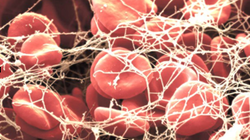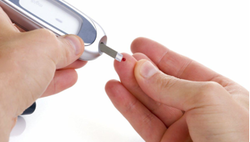 Queshi at al. have published a nice retrospective cohort study in order to answer the question if you should restart anticoagulation in patients with atrial fibrillation (AFib) after an event of gastrointestinal bleeding (GIB). If yes, will I harm the patient by doing so and when should I restart anticoagulation? In five years (2005-2010) 1329 patients developed major GIB. In 49.1% of these patients Warfarin was restarted and this was associated with decreased thromboembolism and reduced mortality. They were able to show that restarting Warfarin after 7 days was not associated with increased risk of GIB, but also reduced risk for thromboembolism and death compared to resume after 30 days of interruption. So, according to these data it seems safe to restart anticoagulation in these patients 7 days after a major GI bleed... and you even seem to do something good for your patient! Qureshi et al. Am J Cardiol. Nov 2013  Already years ago it has been noticed that stress and severe injury results in insulin resistance among ICU patients. This also occurs in patients who had no diabetic problems before an insult. Van den Berge et al. therefore postulated that an intensive glucose control in ICU patients would be of benefit. And indeed, in 2001 they published the well known article on intensive insulin therapy in critically ill patients. They showed that a tight glucose control results in reduced morbidity and mortality (by 42%) among ventilated, critically ill patients in surgical intensive care units (1548 patients included). Unfortunately though some clinical trials since have failed to reproduce this benefit of tight glucose control. A meta analysis in JAMA 2008 looked at 28 randomized controlled trial with a total of 8432 patients and found that tight glucose control was not associated with significantly reduced hospital mortality but an increased risk of hypoglycemia. The multinational NICE-SUGAR trial, including 6104 patients, finally made an end to tight glucose control on most ICU’s around the world. Against expectation mortality in the intensive-control group was higher as well as severe hypoglycemia. No difference though was observed in regards of length of stay in ICU, duration of hospitalization, days of mechanical ventilation, rate of pos. blood cultures and RBC transfusion. This month Kalfon et al. add another puzzle piece to this ongoing discussion with an article published in Intensive Care Medicine. This multi-center randomized trial included 2648 patients who were randomly assigned to tight computerized (CDSS) glucose control or conventional glucose control. And guess what: tight glucose control did not change 90-day mortality but was associated with more frequent severe hypoglycemia... In summary: there is not much in favor for tight glucose control coming up and there’s no need to invest in more expensive computers... Sweet! Kalfon P. et al. Intensive Care Med. 2014 Jan 14 van den Berghe, G. et al. Intensive insulin therapy in critically ill patients. N. Engl. J. Med. 345, 1359–1367 (2001) NICE-SUGAR study investigators. Intensive versus conventional glucose control in critically ill patients. N. Engl. J. Med. 360, 1283–1297 (2009) Wiener, R. S., Wiener, D. C. & Larson, R. J. Benefits and risks of tight glucose control in critically ill adults: a meta-analysis. JAMA 300, 933–944 (2008) Targeted Temperature Management Trial: Is it Time to Stop Cooling Patients after Cardiac Arrest?6/1/2014
 In 2002 two published articles in the New England Journal of Medicine changed ICU management of out of hospital arrests profoundly. According to these two articles (cited below) the American Heart Association labeled this to be good evidence (Level1) to recommend induced hypothermia in comatose survivors of out of hospital cardia arrest caused by VF. The target temperature was recommended to be between 32-34°C and to be maintained for 12-24 hours. And now this... Nielsen et al. present the Targeted Temperature Management Trial showing, that there is NO difference between patients cooled to 33°C and patients kept at 36°C. Is this the end of the cooling era, should we change our management? I personally think think that this trial basically adds up to our knowledge in the field of post cardiac arrest care, but not necessarily contradicts the previous two trials. We now have one trial showing that there seems to be no difference between 33°C and 36°C but we also know, that hyperthermia (pyrexia) is troublesome and associated with worse neurological outcome. So, as pronounced hypothermia (33°C) makes no difference to ‘mild’ hypothermia (36°C) and pyrexia is proven to be harmful... the question is: What is the right temperature? We seem to head towards normothermia or mild hypothermia in order to provide best management for our patients. It’s going to be interesting to see how recommendations will change in the near future. The Targeted Temperature Management Trial: Nielsen N, et al. New Engl J Med. 2013 Dec;369(23):2197-206 The 2 trials that introduced therapeutic hypothermia into ICU practice: The Hypothermia After Cardiac Arrest Study Group, Holzer at al. New Engl J Med. 2002 Feb;346(8):549-556 Bernard S.A. et al. New Engl J Med. 2002 Feb;346(8):557-563 Review article on therapeutic hypothermia for non-VF/VT cardiac arrest: Sandroni S. et al. Crit Care Med; 2013;17:215 Pyrexia and neurological outcome: Leary M. et al. Resuscitation. 2013 Aug;84(8):1056-61 |
Search
|


 RSS Feed
RSS Feed


